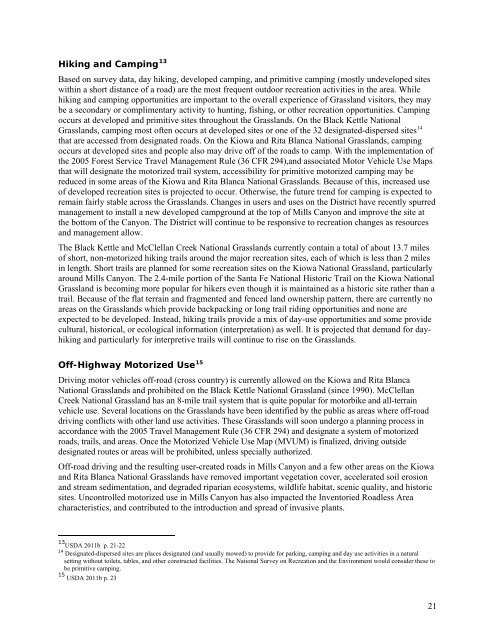Comprehensive Evaluation Report
Comprehensive Evaluation Report
Comprehensive Evaluation Report
You also want an ePaper? Increase the reach of your titles
YUMPU automatically turns print PDFs into web optimized ePapers that Google loves.
Hiking and Camping 13<br />
Based on survey data, day hiking, developed camping, and primitive camping (mostly undeveloped sites<br />
within a short distance of a road) are the most frequent outdoor recreation activities in the area. While<br />
hiking and camping opportunities are important to the overall experience of Grassland visitors, they may<br />
be a secondary or complimentary activity to hunting, fishing, or other recreation opportunities. Camping<br />
occurs at developed and primitive sites throughout the Grasslands. On the Black Kettle National<br />
Grasslands, camping most often occurs at developed sites or one of the 32 designated-dispersed sites 14<br />
that are accessed from designated roads. On the Kiowa and Rita Blanca National Grasslands, camping<br />
occurs at developed sites and people also may drive off of the roads to camp. With the implementation of<br />
the 2005 Forest Service Travel Management Rule (36 CFR 294),and associated Motor Vehicle Use Maps<br />
that will designate the motorized trail system, accessibility for primitive motorized camping may be<br />
reduced in some areas of the Kiowa and Rita Blanca National Grasslands. Because of this, increased use<br />
of developed recreation sites is projected to occur. Otherwise, the future trend for camping is expected to<br />
remain fairly stable across the Grasslands. Changes in users and uses on the District have recently spurred<br />
management to install a new developed campground at the top of Mills Canyon and improve the site at<br />
the bottom of the Canyon. The District will continue to be responsive to recreation changes as resources<br />
and management allow.<br />
The Black Kettle and McClellan Creek National Grasslands currently contain a total of about 13.7 miles<br />
of short, non-motorized hiking trails around the major recreation sites, each of which is less than 2 miles<br />
in length. Short trails are planned for some recreation sites on the Kiowa National Grassland, particularly<br />
around Mills Canyon. The 2.4-mile portion of the Santa Fe National Historic Trail on the Kiowa National<br />
Grassland is becoming more popular for hikers even though it is maintained as a historic site rather than a<br />
trail. Because of the flat terrain and fragmented and fenced land ownership pattern, there are currently no<br />
areas on the Grasslands which provide backpacking or long trail riding opportunities and none are<br />
expected to be developed. Instead, hiking trails provide a mix of day-use opportunities and some provide<br />
cultural, historical, or ecological information (interpretation) as well. It is projected that demand for dayhiking<br />
and particularly for interpretive trails will continue to rise on the Grasslands.<br />
Off-Highway Motorized Use 15<br />
Driving motor vehicles off-road (cross country) is currently allowed on the Kiowa and Rita Blanca<br />
National Grasslands and prohibited on the Black Kettle National Grassland (since 1990). McClellan<br />
Creek National Grassland has an 8-mile trail system that is quite popular for motorbike and all-terrain<br />
vehicle use. Several locations on the Grasslands have been identified by the public as areas where off-road<br />
driving conflicts with other land use activities. These Grasslands will soon undergo a planning process in<br />
accordance with the 2005 Travel Management Rule (36 CFR 294) and designate a system of motorized<br />
roads, trails, and areas. Once the Motorized Vehicle Use Map (MVUM) is finalized, driving outside<br />
designated routes or areas will be prohibited, unless specially authorized.<br />
Off-road driving and the resulting user-created roads in Mills Canyon and a few other areas on the Kiowa<br />
and Rita Blanca National Grasslands have removed important vegetation cover, accelerated soil erosion<br />
and stream sedimentation, and degraded riparian ecosystems, wildlife habitat, scenic quality, and historic<br />
sites. Uncontrolled motorized use in Mills Canyon has also impacted the Inventoried Roadless Area<br />
characteristics, and contributed to the introduction and spread of invasive plants.<br />
13 USDA 2011b p. 21-22<br />
14 Designated-dispersed sites are places designated (and usually mowed) to provide for parking, camping and day use activities in a natural<br />
setting without toilets, tables, and other constructed facilities. The National Survey on Recreation and the Environment would consider these to<br />
be primitive camping.<br />
15 USDA 2011b p. 23<br />
21
















